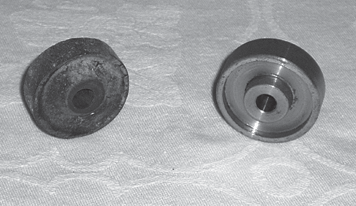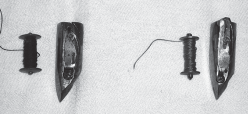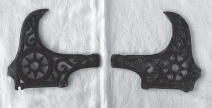Manufacturing Parts for Vintage Sewing Machines
Often, when collectors acquire old or antique sewing machines, they are missing parts. Unfortunately, these missing parts make the sewing machine unusable and restoring a machine to working condition will require some clever engineering. After collecting machines for a number of years, I began to realize that if I wanted to have most of the machines in my collection in working condition, I would have to make my own replacement parts.

Since I am an engineer by trade and have a terrific workshop (where I currently work) at my disposal, all that was required by me was a little brainwork, some hands-on machining in the workshop, and some free time. It didn"t take long for me to realize that, many of the missing parts could be easily replaced either by adapting parts from other machines or making up new parts. I decided to begin with some of the simpler items: spool pins and felt pads. The spool pins I sourced from pins from roller chain, and the felt pads involved machining a wad punch and then cutting out as many as were required from red felt.

With these two successes, I decided to tackle a couple more commonly missing or broken items: treadle wheels and handles for hand crank machines. More often than not, treadle frames are either missing one or two wheels or the existing wheels will have big flat spots, so I decided to tackle that problem first. This task turned out to be much easier than anticipated. We sat down, wrote a program for one of our computer controlled lathes, and in about 20 minutes had 20 wheels made. Luckily, for me, Singer and most other manufacturers use 1/4" shaft so it is easy to obtain in long lengths of stock and then cut to size. As a side note, I quickly used or sold the entire first set of wheels and recently made another batch. I also have access to manually operated lathes I have successfully made a number of wooden handles fro hand crank machines. Since Singer hand crank machines are the most common, I use a rough drawing with some basic dimensions and go from there. However all hand cranks are slightly different and each of these handles are one off specials, made specifically for each machine.
Slide plates are another item commonly missing. Plates such as those found on Singer model 15, 201 or 66 machines are easy enough to find genuine spares, but plates from earlier machines such as the transverse shuttle style machines or earlier types are another issue altogether.
To manufacture these I will cut a piece of steel to approximately the correct size and then hand file to get a good fit. Generally making a slide plate is not overly time consuming. The exception however, is for some of the small English made machines like the Shakespear or Collier. Slide plates for these are stepped and instead of a sloping side, have a very fine groove cut along the side of the plate making them a nightmare to file straight and even.
German made machines are very common here in Australia and many are hand crank machines with a locking dome top cover. Often the base or dome on these machines will be missing the latches that hold the two of them together. Although I have not yet found a source of locks, all the other plates can be easily made. The piece most often missing is the plate with a curved tongue that locks one end of the dome into the base. Luckily, this is a simple piece to make and simply involves a little time with a file and saw. Once the basic shape is cut out, the screw holes are drilled and the tongue is bent by placing it in a vice and hitting it, till an angle just short of 90 degrees is obtained. Finally, the piece is given a good polish and fitted to the dome. The result looks correct, and is difficult to tell from an original part.

Another interesting job was to make a shuttle and bobbin for a New Home Little Worker. Anyone who owns one of these knows that the shuttle and bobbin are much shorter than standard, but are the same diameter and radius on the side. I started by taking a spare (full size) vibrating shuttle and then cut it down to fit the carrier. Then I reground the radius to make a reasonable fit. Making the bobbin was easy. I took a regular length bobbin, and since the brass ends are just pressed on, I was able to push one end down until the correct length was attained, and then cut the shaft to suit. The only thing I couldn't reduce in length was the tension spring on the shuttle. Fortunately, it only hung over the end a small amount and I was able to solder it into place to stop it from moving. Last, I threaded up the machine to check how it worked and with some minor tension adjustments everything worked quite well.
After this, I was asked to make a number of missing parts for a Cookson machine. I made the parts for a collector here in Adelaide, Australia. He had two machines; one that was complete, and the other one that he recently sold. The sold machine had a broken feed assembly, and before he could ship it out to the buyer, he needed replacement parts made. Fortunately, the collector agreed to let me borrow the complete machine to use as a pattern. Cookson machines are a walking foot feed, and the mechanism is rather complicated. A shaft attaches to the foot and a piece halfway up this rod holds everything in place to help guide the foot.
I began the exercise by machining the part to an approximate size and dimension on a milling machine at work. The rest of the work was done by hand, drilling, filing, fitting etc. All told, I initially spent around 4 hours on the milling machine, and then another 5 or 6 hours drilling filing and cutting the parts to get a good fit and to look like the originals. To me the handwork is the most important. A 100-year-old machine needs to have parts that look age appropriate. Replacement parts that look new only stand out and detract from the machine"s beauty. Finally, a spring was required to complete the assembly. In this case, I found a spring of similar size and weight and simply cut it to length. Although it was a big job and could have been a nightmare, both the collector and I were pleased with the results. This job definitely has its benefits; my payment was a Shakespear sewing machine.

Not all of my projects are for other people; sometimes I can manage to squeeze in a personal project or two. My most recent, and ambitious project to date is the above scroll plate for the rear of my Ward Arm & Platform machine. It is a fancy plate with lots of fancy design and scrollwork. This is one is definitely a labor of love as I can envision at least 20 hours filing all that fiddly scrollwork and for me more than an hour at a time on handwork is more than enough to drive me crazy.
I am sure that as I continue to add more machines to my collection and as I am asked to repair and mill parts for others, the challenges will continue. For me, truly half the fun is taking an old, seized or damaged machine and making it work like the day it was made.
Editor"s Note: Rob tells us that he is currently making a front slide plate for a Singer fiddlebed machine and has a few more projects waiting in the wings. He also welcomes your questions, inquiries, and comments. If you would like more information, please feel free to email Rob at [email protected].






